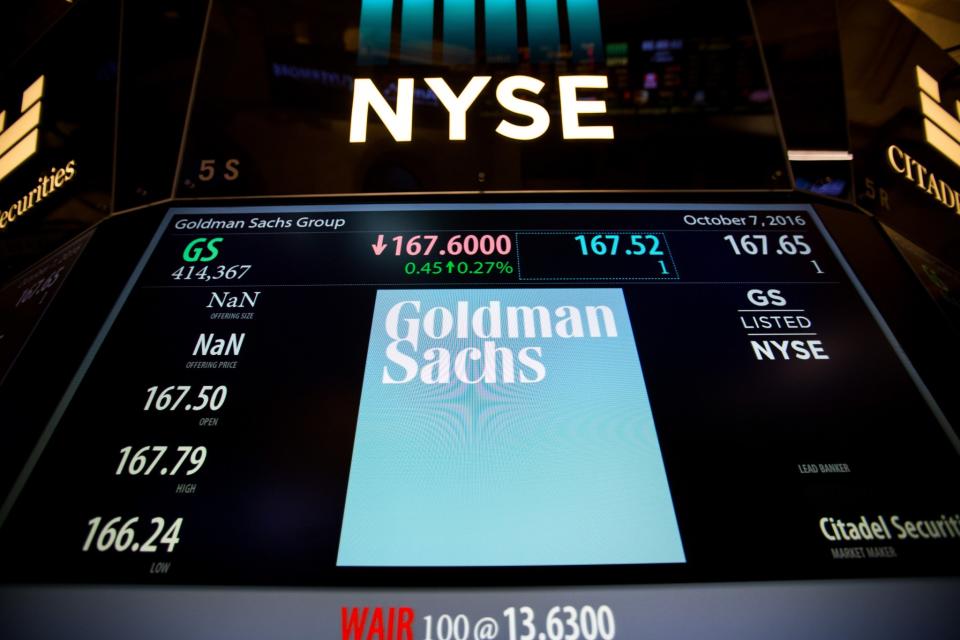Goldman Sachs is soaring after it axed consumer banking—analysts see stock over $500

Goldman Sachs shares have rallied 34% in the year since the bank disclosed an embarrassing $470 million loss resulting from the closure of Marcus personal loans, the bank's first foray into the sale of its ill-fated consumer banking. Up from $336 last April, the bank's stock reached an all time high of $470 in May, and is now priced around $452. Mike Mayo, the head of Wells Fargo Securities U.S. large-cap bank research, says the stock could cross the $500 mark in the coming year.
It's a far cry from a year ago when The Economist called Goldman a “Wall Street laggard” that had “lost its swagger.” Mayo credits Goldman’s rapid turnaround to the decision to cut its losses at Marcus and other consumer financial products and return to its core competencies banking big business.
“Goldman is back,” Mayo told Fortune. “The mass market consumer has never been Goldman's forte, and they went ahead, and in my view, wasted several billion dollars, diverted management attention, and it was just to me, a foray that never should have been attempted.” Mayo has marked Goldman’s stock a “buy” with a target price of $504. An analyst from Oppenheimer & Co. places the target at $517, while Morningstar marks it as a “hold” at $417.
In 2022, Goldman announced plans to shutter its consumer and wealth management segment, and move Marcus Invest and Marcus Deposits, which offers users high-yield savings accounts, to the asset and wealth management business. With the retail banking business “on the back burner,” as Mayo says, roughly two thirds of the company is global banking markets, and a third is wealth and asset management.
Goldman also pivoted way from one of its "hobbies," in Mayo's words, selling its home improvement consumer loan originator GreenSky to Sixth Street for an undisclosed amount, estimated to be between $62 million and $500 million. Just two years earlier Goldman would buy the company as part of its push into retail for $2.24 billion in an all-stock transaction. The deal closed three years later for
Goldman in the post-retail era
To maintain the upward trajectory Mayo wants to see Goldman continue to exit these projects, including the final bits of Marcus Invest, which should happen in less than a week. According to the Marcus by Goldman Sachs website any accounts still open as of June 29 will be transferred to their new owner, Betterment.
With retail now deprioritized, Mayo says Goldman will likely turn its attention to growing the wealth and asset management part of its services from single digit returns on investment last year to "perhaps low double digits in 2024 and to mid-teens longer term." Last month Goldman raised more than $20 billion from private investors for direct lending.
“Raising third party funds for private capital leverages Goldman's unique relationship with institutions and investors,” says Mayo. In Goldman’s latest investor report for the quarter ending March 31, the bank reported net revenues of $14.21 billion and net earnings of $4.13 billion. The annualized return on average common shareholders’ equity was 14.8%.
Those funds could soon get a boost now that the Fed is reportedly considering reducing the capital requirements of big banks. If the capital requirement, which is designed to mitigate risk should a bank collapse, were reduced, it would free up capital to invest elsewhere.
Goldman's rebound may have caught some by surprise, but beneath the surface the bank's stock performance has been on a long, slow upward trajectory. It has grown by 131% over the past five years and more than 500% since it went public 25 years ago in May.
Coming at a time when Wall Street is turning its back on making investment decisions that consider diversity, equity and inclusion, known as DEI, Goldman last week reportedly doubled the number of participants it will admit to its free Black in Business education program, part of a plan to invest $10 billion in a million black women entrepreneurs.
While Goldman Sachs’ stock increased 16% this year so far, its Big Four competitors, Wells Fargo, Bank of America, JPMorgan Chase & Co., and Citigroup have increased by 18%, 17%, 14% and 12% respectively. The S&P 500 increased by 15% year-to-date, while the SPDR S&P Bank ETF that tracks a broader cross section of financial institutions including custody banks, regional banks and diversified financial services has been relatively neutral, decreasing slightly from $45.64 on January 2 to $44.86 today, according to S&P Capital IQ.
This story was originally featured on Fortune.com

 Yahoo Finance
Yahoo Finance 